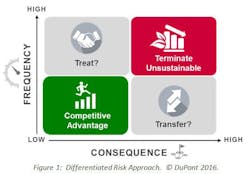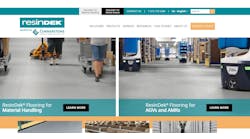Pursue the Common Ground in Effective Operational Risk Management and Operational Excellence
Companies that want to achieve a sustainable and profitable business need to focus on three dimensions of their operations, generally speaking. First is value protection, a foundational concern that relates to protecting the people and assets of a company. Second is value extraction, which focuses on operating assets most efficiently to generate improved returns on investment. Finally, value creation relates to improving a company’s corporate sustainability with respect to having a positive impact on people, the environment and shareholder returns.
There are usually questions raised about whether these three dimensions can be sought simultaneously, or implemented sequentially. That generally depends on the capacity and capability that exists within the company. Identifying and prioritizing opportunities for risk reduction and improving efficiencies have to be seen in totality. In some operations such as tank terminals, the risks are much higher than the opportunities for improving efficiencies. In others, improving operational efficiencies may provide the necessary funding to reduce risks. A company’s leadership has to look at the holistic picture before making choices.
The successful pursuit of these three dimensions requires companies to effectively manage their operational risk and be continuously committed to the goal of operational excellence. Of course, developing an operational risk management (ORM) plan and an effective approach toward operational excellence are not accomplished overnight, but there are key elements common to achieving both that organizations can put into practice.
Identifying and understanding the common ground between ORM and operational excellence requires a brief examination of each.
Operational Risk Management
Risk is assessed by evaluating the potential for incidents along with the degree of impact they could have on an organization should they occur. That means enterprises face a wide spectrum of potential risks, ranging from high frequency/low severity risks to low frequency/high severity risks, and everything in between. The range of risks may vary between one company and another depending upon several factors, such as physical location, prevailing culture, competency and operating discipline. Given the wide range of potential risks and a limit on the resources that a company can devote to risk management, it makes sense to adopt a strategy that assigns appropriate effort to potential risks. There is no one-size-fits-all approach to mitigating the risks a company faces, and it is simply not practical to address all risks with the same level of intensity.
Companies have had success adopting what DuPont Sustainable Solutions (DSS) refers to as a “differentiated risk” approach. (Figure 1) This strategy ensures that appropriate effort and resources are expended based on the specific risk profile of the industry and business in which a company operates. This results not only in optimal risk management for an organization, but also ensuring value for the investment, giving companies a competitive advantage in their business sector. Successful ORM lies in identifying, evaluating and controlling losses and differentially managing associated risks.
By ranking operational risks, there will be a consistent way of recognizing risks across a company that ensures what is classified as a risk is not driven solely by individual perception. The whole purpose of having a structured risk management process is not just to improve efficiencies, but to improve the effectiveness with which a company addresses them. All too often, companies measure risk mitigation by focusing on the quantity of new policies or procedures implemented rather than achieving actual risk reduction. Adopting an operational risk management approach helps companies achieve greater risk reduction by optimizing resources.
Operational Excellence
Consistently high-performing companies benefit from “doing it right every time,” but they then leverage their error-free operations to focus on and address other critical operational improvements within the organization that allow it to reach operational excellence. In this regard, safety processes are important, but high-performing companies must also concern themselves with processes that address reliability and maintenance, operating to plan, manufacturing technology, supply chain and facility improvements. But how can companies identify and execute these processes in a manner that doesn’t simply generate reams of documentation, procedures and data that do not support the goals of operational excellence?
To start, companies should initiate a benchmarking exercise to examine the current state of their core processes. This benchmarking will assess company strengths, gaps to close, potential financial impact of procedures, and, more importantly, change readiness in the organization. Initiatives can then be driven across locations and functions as appropriate. The benchmarking assessment acts as a compass to guide a company’s areas of focus, identifying areas that need change and what value the change will bring. From the benchmark, an overall roadmap of operations can be established that aligns to the overall business planning process.
It is important that the resulting roadmap be standardized across the company. Standardization reduces variations that can lead to ineffectiveness and ensures that every worker who is charged with the responsibility of improving a process approaches it in the same way, using the same techniques, which enables effective implementation. This prevents numerous departments, sites and functions across the company from “re-inventing the wheel,” which only adds to corporate costs. At the same time, there should be sufficient flexibility so that practices are not driven forward across all levels of the organization with the same intensity – each of the businesses and sites should implement them based on their prioritized needs.
Where is the Common Ground?
There are four important considerations that companies should focus on to successfully pursue both ORM and operational excellence:
1. “Corporate push” vs. “site pull.” As mentioned above, companies should avoid the trap of falling for the newest approach in the marketplace and driving its implementation across the organization. Rather than a blanket mandate for implementation of an initiative coming from the C-Suite, companies should empower individual site locations to implement procedures only if they are relevant to that site and will create value for the company. By outlining expectations for the company and allowing individual sites and functions to prioritize the processes they will follow to meet those expectations, organizations will be in a much better position to achieve the outcomes they seek. This approach avoids initiative fatigue where people simply complete mandated forms to meet corporate requirements.
2. Integrated approach focused on outcomes. It is easy for companies to become inundated with initiatives and procedures, and therefore lose sight of the importance of focusing only on implementing those that actually generate positive outcomes. Simply assigning technical solutions to problems and driving compliance to systems or procedures isn’t enough. What is optimal is pursuing an integrated approach that links key functions of the organization toward the common goal of driving desired outcomes. (Figure 2) This includes managing processes to translate desired outcomes into key performance indicators at all levels of the organization and establish the organizational structure to keep the company focused on the outcomes that matter. A technical model is developed to standardize tools and practices. Capability building ensures workers receive the right training and mentoring to implement processes focused on desired outcomes. Finally, desired mindsets and behaviors that align all employees to the key purpose and objectives must be continually instilled across the company, particularly through active participation of the organization’s leadership. Adopting consistent mindsets and behaviors helps in addressing a wider number of opportunities whether in terms of reducing operational risks or improving operational excellence.
3. Operational discipline. Simply put, operational discipline means complying with a set of well thought-out and well-defined processes the right way every time. By providing more predictability so tasks don’t need to be completed over and over, inefficiently, day after day, operational discipline improves practices across an organization, allowing leaders and employees to address things that are critical to the day-to-day operations of the business in a timely and efficient manner. When an organization reliably and regularly applies operational discipline, a ripple effect of benefits occurs, each having the power to unleash rapid and continuous improvement as well as waves of innovation. Ideally, operational discipline becomes a part of a company’s culture, driving significantly improved results.
4. Organizational transformation. Having invested considerable time and resources in the pursuit of ORM and operational excellence, companies naturally want desired behaviors and processes to stick. This often requires bringing transformational change to a company’s culture so behaviors and processes become self-sustaining. Case studies of successful transformation clearly indicate that developing a shared vision, in which every employee feels ownership to the transformational effort, is a critical success factor. It involves ensuring there is clarity among employees as to the vision and direction of the company; making sure employees have an understanding that they will be held accountable for achieving desired outcomes; and promoting a work environment in which employees are not only encouraged to contribute their ideas toward achieving desired outcomes, but feel that their opinions are valued.
The journey toward effective ORM and the ongoing pursuit of operational excellence require significant attention and commitment, but the outcomes in terms of improved business and financial performance are well worth it. Pursuing areas of common ground between both ORM and operational excellence can make the journey easier, and in the process create a workforce that feels empowered to take an active role in contributing to their company’s growth and success.
Srini Ramabhadran is global practice leader for process safety and operational risk management with DuPont Sustainable Solutions. He has more than 27 years international experience leading cross-functional and cross-regional teams to facilitate the sustainable transformation of organizational culture in the area of operational risk management. At DuPont he leads the assessment, learning and development, and facilitated implementation of process and behavioral safety and environmental management solutions.






